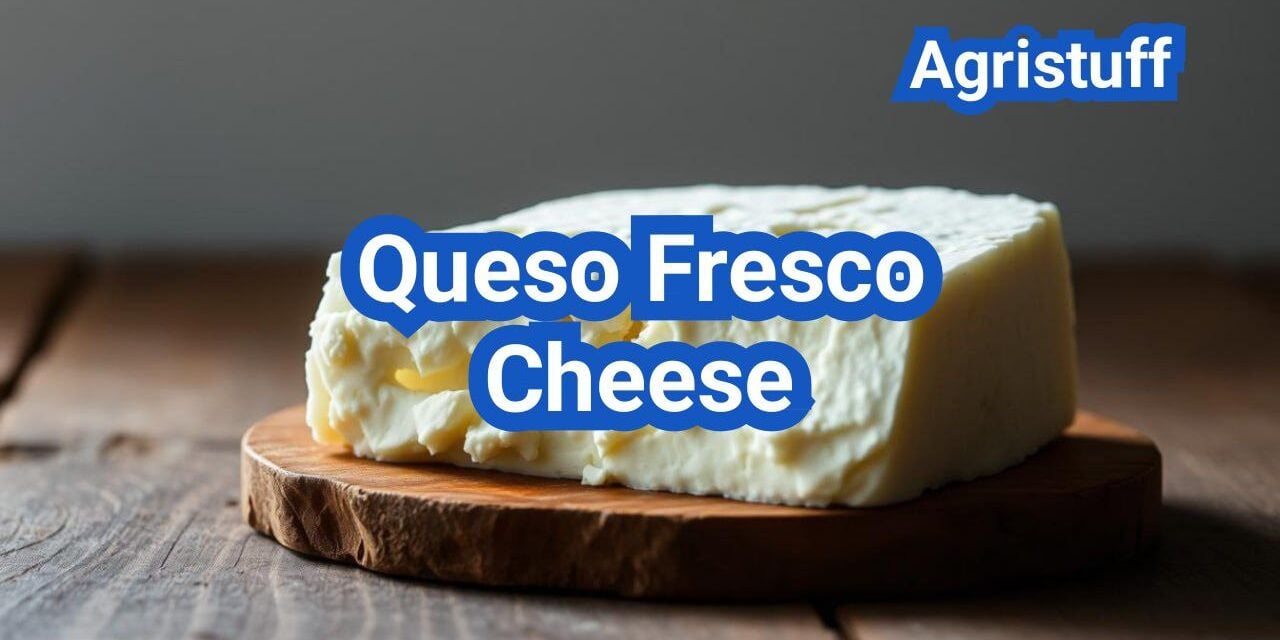Queso Fresco Cheese, a staple in Mexican cuisine ( Mexican cheese ), has a rich history that spans centuries. Originating in Spain, this fresh crumbly cheese has become an integral part of Mexican cooking.
Characterized by its mild flavor and soft texture, Queso Fresco is similar to feta cheese. It’s a versatile ingredient used in various dishes, from salads to traditional Mexican recipes.
The history and types of Queso Fresco Cheese are as fascinating as its uses. Understanding its processing steps and the equipment used can provide insights into its production.
Key Takeaways
- Queso Fresco Cheese originated in Spain but is closely associated with Mexican cuisine.
- It’s a mild, soft, and crumbly cheese, similar to feta.
- The cheese is versatile and used in various Mexican dishes.
- Understanding its processing steps and equipment can provide insights into its production.
- Queso Fresco Cheese is a staple ingredient in many traditional Mexican recipes.
What Is Queso Fresco Cheese?
The world of Mexican cuisine is incomplete without Queso Fresco, a cheese that embodies freshness and simplicity. Queso Fresco, which translates to “fresh cheese,” is a staple in Mexican cooking, cherished for its unique characteristics and versatility in various dishes.
Definition and Basic Characteristics
Queso Fresco is a soft, fresh Mexican cheese ( soft cheese ) traditionally made from raw cow milk or a combination of cow and goat milk. In the United States, pasteurized versions are more common. This cheese is known for its white color and crumbly texture, making it an excellent addition to various Mexican dishes. The flavor profile of Queso Fresco is mild, slightly tangy, and salty, which complements a wide range of culinary applications.
Cultural Significance in Mexican Cuisine
Queso Fresco holds significant cultural value in Mexican cuisine, often used in traditional dishes such as tacos, salads, and enchiladas. It’s also a key ingredient in many celebratory meals and family gatherings. The table below highlights some common uses of Queso Fresco in Mexican cuisine:
| Dish | Role of Queso Fresco |
|---|---|
| Tacos | Crumbled on top for added flavor |
| Salads | Crumbled or sliced for texture |
| Enchiladas | Used as a topping or mixed into the filling |
In summary, Queso Fresco is not just a type of cheese; it’s an integral part of Mexican culinary heritage, bringing people together through its presence in various traditional and celebratory dishes.
The Rich History of Queso Fresco
With roots in Spanish Colonial Mexico, Queso Fresco has evolved significantly over time. Compared to the history of famous cheeses of Europe and the origins of cheesemaking in Asia, which go back thousands of years, Mexico’s cheese culture is relatively new, arriving with the cattle brought by early Europeans just 500 years ago.
Origins in Spanish Colonial Mexico
The introduction of dairy farming by Spanish colonizers in the 16th century marked the beginning of Queso Fresco’s history. Queso Fresco, which translates to “fresh cheese,” was initially produced as a simple, fresh cheese for local consumption. The cheese quickly became an integral part of Mexican cuisine, particularly in traditional dishes.
Evolution Through the Centuries
Over the centuries, Queso Fresco has undergone significant changes influenced by various cultural and historical factors. As Mexican cuisine evolved, so did the production methods and recipes for Queso Fresco. Today, it remains a staple in Mexican cooking, with its crumbly texture and mild flavor making it a versatile ingredient in many recipes.
The evolution of Queso Fresco reflects the broader culinary history of Mexico, shaped by indigenous, Spanish, and other international influences. As a result, Queso Fresco is not only a reflection of Mexico’s rich cultural heritage but also a testament to the country’s ability to adapt and innovate.
Types of Queso Fresco Cheese
Queso Fresco cheese, a staple in Mexican cuisine, comes in various types that cater to different tastes and production methods. Nearly a quarter of the milk produced in Mexico goes into cheese, and of that cheese, 70% is made by small-scale producers, contributing to the diverse range of Queso Fresco varieties.
Traditional vs. Commercial Varieties
Traditional Queso Fresco is made using age-old methods passed down through generations, typically involving raw cow’s milk or a combination of cow and goat’s milk. In contrast, commercial varieties often use pasteurized milk and standardized production processes to ensure consistency and longer shelf life. While traditional Queso Fresco has a distinct, tangy flavor, commercial versions may have a milder taste.
Regional Variations Across Mexico
Mexico’s diverse regions each have their own version of Queso Fresco, influenced by local traditions and available milk sources. For instance, some regions may produce a softer, creamier Queso Fresco, while others may make it drier and crumblier. These regional variations add to the richness of Queso Fresco cheese in Mexican cuisine.
Artisanal and Mass-Produced Differences
Artisanal Queso Fresco is typically handmade in small batches, allowing for unique flavors and textures. Mass-produced Queso Fresco, on the other hand, is made on a larger scale, often using automated processes. While artisanal cheese may have a more pronounced flavor, mass-produced versions offer consistency and wider availability.
| Type of Queso Fresco | Production Method | Characteristics |
|---|---|---|
| Traditional | Raw milk, handmade | Tangy flavor, crumbly texture |
| Commercial | Pasteurized milk, standardized process | Milder taste, longer shelf life |
| Artisanal | Small batches, handmade | Unique flavors, varied textures |
| Mass-Produced | Large scale, automated | Consistent taste, widely available |
The Distinctive Properties of Fresh Crumbly Cheese

With its crumbly texture and mild flavor, Queso Fresco stands out among Mexican cheeses. This fresh crumbly cheese has gained popularity not only for its taste but also for its unique properties that make it versatile in various culinary applications.
Texture Profile of Queso Fresco
The texture of Queso Fresco is one of its most defining characteristics. It is known for being soft and crumbly, making it easy to break apart or crumble over dishes. This texture is a result of the cheese-making process, which involves curdling milk and then draining it without pressing, resulting in a fresh, moist cheese.
The crumbly nature of Queso Fresco makes it an excellent addition to various dishes, from salads to traditional Mexican recipes like tacos and enchiladas. Its texture adds a pleasant contrast to softer or smoother components of a meal.
Flavor Characteristics and Tasting Notes
Queso Fresco’s flavor profile is mild and slightly tangy, with a freshness that is reminiscent of its young age. The taste is often described as clean and milky, with a subtle saltiness that enhances its overall flavor without overpowering it.
Tasting notes for Queso Fresco often include descriptions of its creamy undertones and a hint of acidity, which contribute to its refreshing taste. The flavor is versatile enough to complement a wide range of ingredients, from the sweetness of fruits to the spiciness of chilies.
The combination of Queso Fresco’s texture and flavor makes it a valuable ingredient in many recipes, offering a unique sensory experience that enhances the overall dining experience.
Step-by-Step Queso Fresco Cheese Processing
Queso Fresco cheese processing is a multi-step procedure that includes milk preparation, curdling, draining, and shaping. This traditional Mexican cheese is made through a straightforward yet precise process that transforms simple ingredients into a delicious final product.
Step 1: Milk Selection and Preparation
The first step in making Queso Fresco is the selection and preparation of milk. High-quality, fresh milk is essential for producing the best flavor and texture. Producers typically use cow’s milk, though a combination of cow and goat’s milk can also be used for a richer taste. The milk is heated to a specific temperature to prepare it for the next step.
Step 2: Curdling Process
Once the milk is prepared, rennet and cultures are added to initiate the curdling process. Rennet helps in coagulating the milk, separating it into curds and whey. The mixture is left to sit for a period, allowing it to curdle properly. This step is crucial as it determines the final texture of the cheese.
Step 3: Draining and Pressing Techniques
After curdling, the mixture is transferred to a cheesecloth or a colander lined with cheesecloth, where the whey is drained off. The curds are then pressed gently to remove excess liquid. This step is important for achieving the characteristic crumbly texture of Queso Fresco. The pressing is typically done for a few hours or overnight.
Step 4: Final Shaping and Packaging
The final step involves shaping the cheese into its desired form, usually a wheel or block, and packaging it for distribution. Queso Fresco is often sold fresh, so it’s packaged in a way that maintains its freshness. The cheese is typically wrapped in plastic or vacuum-sealed to prevent drying out.
| Step | Description | Key Considerations |
|---|---|---|
| 1 | Milk Selection and Preparation | Milk quality, temperature control |
| 2 | Curdling Process | Rennet quality, curdling time |
| 3 | Draining and Pressing | Cheesecloth quality, pressing time |
| 4 | Final Shaping and Packaging | Packaging method, storage conditions |
Essential Equipment for Making Queso Fresco

To create authentic Queso Fresco, one must have the right equipment. The process of making this traditional Mexican cheese involves a combination of traditional tools and modern machinery.
Traditional Tools and Utensils
Traditionally, Queso Fresco is made with simple, rustic equipment. The primary tools include:
- Cheesecloth: Used for draining the curds and giving the cheese its characteristic texture.
- Wooden Molds: These molds shape the cheese and help in removing excess liquid.
- Manual Press: A manual press is often used to apply gentle pressure to the cheese, aiding in the removal of whey.
Modern Commercial Equipment
In contrast, modern commercial Queso Fresco production utilizes more advanced machinery to increase efficiency and consistency. Some of the key equipment includes:
- Automated Cheese Molds: These molds can handle larger quantities and provide uniform shaping.
- Centrifuges: Used for efficient whey separation, centrifuges speed up the cheese-making process.
- Temperature-Controlled Vats: These vats allow for precise control over the cheese-making temperature, crucial for developing the cheese’s flavor and texture.
Both traditional and modern equipment play crucial roles in the production of Queso Fresco, each offering unique benefits in terms of authenticity, efficiency, and quality.
Homemade Queso Fresco Recipe

With just a handful of basic components, you can create authentic Queso Fresco in the comfort of your own kitchen. This traditional Mexican cheese is known for its fresh, crumbly texture and mild flavor, making it a versatile ingredient in many dishes.
Ingredients List
To make Queso Fresco at home, you’ll need the following ingredients:
- 1 gallon whole milk
- 1/4 cup vinegar or lemon juice
- 1/4 tsp salt
- Rennet (optional, but recommended for a more authentic texture)
It’s essential to use high-quality milk for the best flavor. You can choose between cow’s milk or a combination of cow and goat’s milk, depending on your preference.
Preparation Instructions
Follow these steps to create your homemade Queso Fresco:
- Begin by heating the milk to 86°F (30°C) in a large pot.
- Add the vinegar or lemon juice and stir gently for about 30 seconds.
- Allow the mixture to sit for 5-10 minutes, until it has fully curdled.
- Line a colander with cheesecloth and place it over a large bowl.
- Carefully pour the curds into the cheesecloth-lined colander.
- Let the mixture drain for about 30-40 minutes, until most of the whey has been removed.
- Gather the edges of the cheesecloth and give the cheese a gentle squeeze to remove any remaining whey.
- Transfer the cheese to a mold or shape it by hand into a round or block form.
Troubleshooting Common Issues
If you encounter any problems during the cheese-making process, refer to these troubleshooting tips:
- If the curds are too soft, it may be due to insufficient acid or incorrect temperature.
- If the cheese is too crumbly, try adjusting the draining time or using a different type of milk.
As Carlos Yescas, a renowned cheesemaker, once said,
“The art of cheese-making lies in understanding the nuances of temperature, acidity, and time.”
By following these guidelines and being mindful of the process, you can create a delicious and authentic Queso Fresco at home.
Queso Fresco Cheese vs. Other Mexican Cheeses

Understanding the differences between Queso Fresco and other Mexican cheeses can enhance culinary experiences. Mexican cuisine is rich in various cheeses, each with unique characteristics and uses.
Queso Fresco vs. Cotija
Queso Fresco and Cotija are both popular Mexican cheeses, but they have distinct differences. Cotija is aged, giving it a sharper flavor and crumbly texture, while Queso Fresco is fresher with a milder taste. The aging process for Cotija can range from a few months to several years, affecting its flavor profile.
| Characteristics | Queso Fresco | Cotija |
|---|---|---|
| Age | Fresh | Aged |
| Flavor | Mild | Sharp |
| Texture | Soft, crumbly | Crumbly |
Queso Blanco vs. Queso Fresco
Queso Blanco, or white cheese, is another Mexican cheese often compared to Queso Fresco. While both are white and can be used in similar dishes, Queso Blanco tends to be creamier and has a higher moisture content. Queso Fresco, on the other hand, is typically drier and more crumbly.
Panela and Requesón Comparisons
Panela and Requesón are other Mexican cheeses that, while different from Queso Fresco, share some similarities. Panela is known for its mild flavor and semi-soft texture, making it a good melting cheese. Requesón, similar to ricotta, is used in desserts and dishes requiring a soft, creamy cheese. While Queso Fresco is often used as a topping or mixed into dishes, Panela and Requesón have their unique applications.
In conclusion, each Mexican cheese has its own characteristics, uses, and flavors. Understanding these differences can help in choosing the right cheese for specific recipes and culinary needs.
The Melting Properties of Queso Fresco Cheese

Queso Fresco’s melting characteristics set it apart in the world of cheese. This Mexican cheese is known for its fresh, crumbly texture, but its melting behavior is often a topic of discussion among cooks and cheese enthusiasts.
Understanding the melting properties of Queso Fresco is crucial for achieving the desired results in various recipes. Let’s explore why Queso Fresco doesn’t melt like other cheeses and how to work with it effectively in cooking.
Why Queso Fresco Doesn’t Melt Like Other Cheeses
Queso Fresco is a type of fresh cheese that doesn’t melt well due to its unique properties. The main reasons for this include:
- High moisture content
- Low acidity
- Specific curdling process
When heated, Queso Fresco tends to soften rather than melt smoothly. This is because of its high moisture content and the way it’s produced. The cheese is made by curdling milk with rennet or acid, then draining and pressing it. This process results in a cheese that doesn’t have the same melting properties as aged or processed cheeses.
Cooking Techniques for Best Results
While Queso Fresco may not melt like other cheeses, it can still be used effectively in various dishes. Here are some cooking techniques to achieve the best results:
| Cooking Method | Effect on Queso Fresco |
|---|---|
| Grilling | Softens and slightly browns the cheese |
| Baking | Melts slightly, creating a creamy texture |
| Frying | Crispies the outside, softens the inside |
To get the most out of Queso Fresco in your recipes, consider crumbling it and adding it towards the end of cooking. This helps preserve its texture and flavor. Experimenting with different cooking techniques can help you achieve the desired consistency and taste in your dishes.
Best Substitutes for Queso Fresco
In the absence of Queso Fresco, cooks can turn to various substitutes that offer similar characteristics and uses in recipes. Whether you’re looking for dairy or non-dairy alternatives, there are several options to consider.
Dairy Alternatives
For those who still want to stay within the realm of dairy products, several cheeses can serve as substitutes for Queso Fresco. Feta cheese is a common substitute due to its similar texture and salty flavor profile. Other options include:
- Cotija cheese: While slightly different in texture, Cotija has a similar Mexican origin and can be used in many of the same dishes.
- Ricotta salata: This Italian cheese has a mild flavor and a firm texture that can work well in place of Queso Fresco in some recipes.
- Goat cheese: Soft goat cheese can provide a similar creaminess to Queso Fresco, although it may lack the crumbly texture.
Non-Dairy Alternatives
For those following a vegan diet or preferring non-dairy options, there are several alternatives that can mimic the texture and flavor of Queso Fresco. Some popular options include:
- Tofu: Extra-firm tofu can be crumbled and seasoned to mimic the texture of Queso Fresco.
- Vegetarian ricotta: Made from plant-based ingredients, this can be a good substitute in recipes that call for Queso Fresco.
- Cashew cheese: Made by blending cashews with water and then culturing the mixture, cashew cheese can provide a similar creaminess to Queso Fresco.
When substituting Queso Fresco, it’s essential to consider the flavor and texture you’re trying to achieve in your dish. Both dairy and non-dairy alternatives can be effective, depending on the context of the recipe.
Proper Storage and Handling of Queso Fresco
To enjoy Queso Fresco at its best, it’s essential to understand how to store and handle it correctly. Proper storage and handling techniques can significantly impact the cheese’s freshness, flavor, and overall quality.
Optimal Storage Temperature
Queso Fresco should be stored in the refrigerator at a temperature below 40°F (4°C). This cool environment helps in slowing down the bacterial growth and preserving the cheese’s texture.
Maintaining the right temperature is crucial. Refrigeration at or below 40°F (4°C) is recommended to keep Queso Fresco fresh for a longer period.
Shelf Life Considerations
The shelf life of Queso Fresco can vary depending on several factors, including its production method, packaging, and storage conditions. Generally, when stored properly in the refrigerator, Queso Fresco can last for several weeks.
| Storage Conditions | Shelf Life |
|---|---|
| Refrigerated at or below 40°F (4°C) | Several weeks |
| Improperly stored | Less than a week |
Signs of Spoilage
It’s crucial to check Queso Fresco regularly for signs of spoilage. These can include an off smell, slimy texture, or mold growth beyond the normal white mold. If you notice any of these signs, it’s best to discard the cheese.
Regular inspection of the cheese for any visible signs of spoilage is a good practice to avoid consuming spoiled cheese.
Safety Concerns with Fresh Mexican Cheese

As the consumption of Mexican cheese grows, so does the concern over its safety profile. Fresh Mexican cheeses, such as Queso Fresco, are made from raw or unpasteurized milk, which can pose health risks due to potential contamination.
Listeria and Soft Cheeses are a significant concern. Listeria is a bacteria that can cause listeriosis, a serious infection that can be life-threatening, especially for pregnant women, the elderly, and people with weakened immune systems. Soft cheeses, including Queso Fresco, are more susceptible to Listeria contamination because of their high moisture content and the fact that they are often made from unpasteurized milk.
Listeria and Soft Cheeses
The risk associated with Listeria in soft cheeses like Queso Fresco is well-documented. The bacteria can contaminate the cheese during the manufacturing process, particularly if proper hygiene practices are not followed. It’s crucial for consumers to be aware of the risks and for manufacturers to adhere to strict safety protocols.
The 60-Day Rule for Raw Milk Cheese
The 60-day rule is a regulation that allows raw milk cheese to be sold if it has been aged for at least 60 days. The theory is that the aging process reduces the risk of harmful bacteria like Listeria. However, this rule may not entirely eliminate the risk, especially for cheeses that are consumed fresh or have a short aging period.
Understanding these safety concerns is vital for both consumers and producers of fresh Mexican cheese. By being informed about the potential risks and taking appropriate precautions, the safety of these products can be improved.
Nutritional Profile of Queso Fresco

Understanding the nutritional profile of Queso Fresco is essential for consumers who are mindful of their dietary intake. Queso Fresco, a type of Mexican cheese, is known for its fresh, crumbly texture and mild flavor. It is a relatively low-calorie cheese, but its nutritional content extends beyond just calories.
Caloric and Macronutrient Content
Queso Fresco is characterized by its low caloric content compared to other cheeses. A typical serving size of Queso Fresco (about 28 grams or 1 ounce) contains approximately 70-80 calories. The macronutrient breakdown reveals that it is primarily composed of protein and fat, with minimal carbohydrates.
| Nutrient | Amount per 28g serving |
|---|---|
| Calories | 70-80 |
| Protein | 6-7 grams |
| Fat | 4-5 grams |
| Carbohydrates | 1-2 grams |
The fat content in Queso Fresco is primarily saturated fat, which is a consideration for those monitoring their fat intake. However, the cheese is also a good source of protein, making it a valuable component of a balanced diet.
Health Benefits and Considerations During Pregnancy
Queso Fresco can be part of a healthy diet due to its high protein and relatively low calorie content. However, its consumption during pregnancy requires careful consideration. Pregnant women are often advised to avoid soft cheeses due to the risk of Listeria contamination. Queso Fresco, being a fresh cheese, may pose a risk if it is made from unpasteurized milk.
Despite these considerations, Queso Fresco also offers health benefits. It is a good source of calcium, essential for bone health, and contains vitamins and minerals that contribute to overall nutritional well-being.
Key Health Considerations:
- High in saturated fat
- Good source of protein and calcium
- Potential risk of Listeria if made from unpasteurized milk
Culinary Uses for Queso Fresco Cheese
The versatility of Queso Fresco makes it a favorite among chefs for both traditional and modern recipes. This Mexican cheese is not only a staple in its native cuisine but has also gained popularity worldwide for its unique flavor and texture.
Traditional Mexican Applications
Queso Fresco is deeply rooted in Mexican cuisine, where it’s used in a variety of traditional dishes. It’s commonly crumbled over tacos, enchiladas, and salads, adding a fresh, tangy flavor. In Mexican households, it’s also used as a filling for quesadillas and empanadas, or served as a topping for soups and stews.
In traditional Mexican cooking, Queso Fresco is often paired with other local ingredients like chiles, beans, and corn. Its mild flavor complements these ingredients without overpowering them, making it a versatile cheese for various recipes.
Modern Fusion Cuisine Uses
Beyond its traditional uses, Queso Fresco has found its way into modern fusion cuisine. Chefs around the world are incorporating this Mexican cheese into innovative dishes, blending it with flavors from other cuisines. For example, Queso Fresco can be used in pasta dishes, adding a unique twist to Italian recipes, or as a topping for pizza, combining Mexican and Italian flavors.
In modern fusion cuisine, Queso Fresco is often used to add a fresh, crumbly texture to dishes. It’s crumbled over grilled meats and vegetables, or mixed into dips and spreads for a creamy, tangy flavor.
Pairing Suggestions
When it comes to pairing Queso Fresco with other foods, the possibilities are endless. For a simple yet delicious snack, try pairing it with fresh fruits like figs or grapes. The sweetness of the fruit complements the savory flavor of the cheese perfectly.
For a more substantial meal, Queso Fresco can be paired with grilled meats or vegetables. The following table provides some pairing suggestions:
| Queso Fresco Pairing | Description |
|---|---|
| Queso Fresco & Figs | Sweet and savory combination, perfect for snacking. |
| Queso Fresco & Grilled Chicken | Adds a tangy flavor to grilled meats. |
| Queso Fresco & Roasted Vegetables | Complements the earthy flavors of roasted vegetables. |
Delicious Queso Fresco Recipes
Queso Fresco cheese recipes offer a delicious way to experience Mexican cuisine. This versatile cheese can be used in a variety of dishes, from appetizers to main courses.
Authentic Queso Fresco Cheese Dip Recipe
A Queso Fresco cheese dip is a perfect addition to any gathering. To make it, you’ll need:
- 1 cup Queso Fresco, crumbled
- 1 cup sour cream
- 1/2 cup mayonnaise
- 1 tablespoon lime juice
- 1 teaspoon cumin
- Salt and pepper to taste
- Chopped cilantro for garnish
Mix all the ingredients together until smooth, then chill before serving. This dip is great with tortilla chips or vegetables.
How to Properly Crumble and Fry Queso Fresco
Crumbled and fried Queso Fresco makes a delicious snack or appetizer. To do this, simply crumble the cheese into small pieces, dust with a little flour, and fry in hot oil until golden brown.
Queso Fresco Sauce Variations
Queso Fresco can be blended into a variety of sauces to accompany your favorite dishes. Here are a few variations:
| Sauce Type | Ingredients | Usage |
|---|---|---|
| Simple Queso Fresco Sauce | Queso Fresco, cream, garlic | Tacos, grilled meats |
| Spicy Queso Fresco Sauce | Queso Fresco, diced jalapeños, cream | Nachos, vegetables |
| Herby Queso Fresco Sauce | Queso Fresco, chopped cilantro, lime juice | Grilled fish, salads |
These sauces can be adjusted to taste by adding more or less of the ingredients. Experimenting with different combinations can lead to new favorite recipes.
The Growing Popularity of Hispanic-Style Cheeses in the U.S.
The U.S. market is witnessing a surge in the popularity of Hispanic-style cheeses, driven by the increasing diversity of the American palate and the growing demand for authentic ethnic cuisine. Hispanic-style cheeses, such as Queso Fresco, are becoming staples in many U.S. households and restaurants.
Market Trends and Consumer Demand
The market for Hispanic-style cheeses is experiencing significant growth, fueled by demographic changes and shifting consumer preferences. Here’s a breakdown of the key trends:
- Increasing Hispanic Population: The growing Hispanic population in the U.S. is driving demand for traditional Hispanic-style cheeses.
- Authenticity and Cultural Connection: Consumers are seeking authentic Hispanic products, including cheeses, to connect with their cultural heritage.
- Foodie Culture: The rise of foodie culture and social media has increased interest in diverse, artisanal, and specialty cheeses.
Artisanal and Commercial Producers
The production of Hispanic-style cheeses in the U.S. is a growing industry, with both artisanal and commercial producers playing significant roles. Some key players include:
- Artisanal Producers: Small-batch, artisanal producers are creating unique, high-quality Hispanic-style cheeses that appeal to consumers seeking authentic products.
- Commercial Manufacturers: Larger commercial manufacturers are also entering the market, offering a range of Hispanic-style cheeses to meet growing demand.
The combination of artisanal craftsmanship and commercial scale production is helping to drive the popularity of Hispanic-style cheeses in the U.S., making them more accessible to a wider audience.
Embracing the Versatility of Queso Fresco
Queso Fresco cheese is a versatile ingredient that has been explored in depth throughout this article. From its rich history and cultural significance in Mexican cuisine to its various types and processing steps, Queso Fresco has proven to be a valuable addition to many dishes.
The distinctive properties of fresh crumbly cheese, such as its texture and flavor characteristics, make it an ideal choice for various culinary applications. Whether used in traditional Mexican recipes or modern fusion cuisine, Queso Fresco adds a unique touch to any meal.
As the popularity of Hispanic-style cheeses continues to grow in the U.S., Queso Fresco is poised to become a staple in many American kitchens. Its versatility in cooking, from crumbling and frying to melting and blending, makes it an exciting ingredient for chefs and home cooks alike.
In embracing the versatility of Queso Fresco, cooks can unlock a world of flavors and textures, elevating their dishes and exploring new culinary possibilities.
FAQ
What is Queso Fresco Cheese?
Queso Fresco is a type of Mexican cheese that is fresh, crumbly, and mild, made from cow’s milk or a combination of cow and goat’s milk.
What does Queso Fresco taste like?
Queso Fresco has a mild, slightly tangy, and salty flavor, with a crumbly texture that is often used to add depth and complexity to various dishes.
How is Queso Fresco Cheese made?
Queso Fresco is made by curdling milk with rennet or acid, then draining and pressing the curds to remove excess liquid, resulting in a fresh, crumbly cheese.
What are the different types of Queso Fresco Cheese?
There are traditional and commercial varieties of Queso Fresco, as well as regional variations across Mexico, each with its own unique characteristics and flavor profiles.
Can you make Queso Fresco Cheese at home?
Yes, Queso Fresco can be made at home using a simple recipe and basic cheese-making equipment, allowing for a fun and rewarding DIY experience.
How do you store Queso Fresco Cheese?
Queso Fresco should be stored in the refrigerator at a temperature below 40°F (4°C), wrapped tightly in plastic wrap or aluminum foil to maintain freshness.
Is Queso Fresco Cheese safe to eat during pregnancy?
Pregnant women should exercise caution when consuming Queso Fresco, as it is a soft cheese that may be made from unpasteurized milk, potentially containing Listeria bacteria.
Can Queso Fresco Cheese be melted?
Queso Fresco does not melt like other cheeses due to its high acidity and crumbly texture, but it can be crumbled or grated and used in various dishes.
What are some substitutes for Queso Fresco Cheese?
Dairy alternatives like Feta or Cottage cheese, and non-dairy alternatives like vegan cheese or tofu, can be used as substitutes for Queso Fresco in various recipes.
How is Queso Fresco Cheese used in Mexican cuisine?
Queso Fresco is a versatile cheese used in various traditional Mexican dishes, such as tacos, salads, and soups, adding flavor and texture to each dish.
What is the nutritional profile of Queso Fresco Cheese?
Queso Fresco is relatively low in calories and fat, but high in protein, calcium, and other essential nutrients, making it a nutritious addition to a balanced diet.
How has the popularity of Queso Fresco Cheese evolved in the U.S.?
The popularity of Queso Fresco has grown in the U.S. due to increasing demand for Hispanic-style cheeses, driven by the growing Hispanic population and interest in international cuisine.
Conclusion of: Queso Fresco Cheese
What is Queso Fresco Cheese?
Queso Fresco Cheese is a fresh, soft, white cheese celebrated for its bright, milky flavor, gentle saltiness, and signature crumbly texture. Unlike aged cheeses, Queso Fresco Cheese is high in moisture and meant to be eaten soon after production, which is why careful handling, refrigeration, and pasteurized milk are emphasized in the U.S. for quality and safety. This approachable style of Queso Fresco Cheese is popular across American supermarkets, farmers’ markets, and Latin grocery stores thanks to its versatility and clean dairy character. FDA consumer guidance on queso fresco–type cheeses
Why Queso Fresco Cheese matters in U.S. kitchens
Queso Fresco Cheese brings brightness to tacos, enchiladas, bowls, eggs, soups, and salads without overpowering other ingredients. For home cooks, Queso Fresco Cheese offers an easy finishing touch: crumble it over spicy foods to balance heat, or add it to fresh salsas, roasted vegetables, and grilled meats for contrast. As interest in authentic Latin flavors expands, Queso Fresco Cheese continues to grow in U.S. home and restaurant use—especially when prepared and stored with food-safety best practices. Extension guide: Fresh cheese made safely (UC ANR/PNW 539)
Taste, texture, and heat behavior of Queso Fresco Cheese
Expect Queso Fresco Cheese to be moist yet firm, crumbly rather than sliceable, and delicately tangy. When heated, Queso Fresco Cheese softens but doesn’t become stringy or elastic like mozzarella; that makes it perfect for sprinkling over hot dishes or giving a quick pan-sear to develop a golden edge while maintaining a creamy center. This gentle heat behavior defines how Queso Fresco Cheese is used across cuisines. Wisconsin Cheese profile: Queso Fresco
How Queso Fresco Cheese relates to other fresh Latin cheeses
In labeling and safety education, Queso Fresco Cheese is often discussed alongside queso blanco, requesón, and panela—each a fresh style with subtle differences in moisture, grain, and behavior with heat. In the U.S., you’ll also see “Hispanic-style” or “Mexican-style” on packages to help shoppers identify the category. Regardless of style, the same food-safety principles apply to Queso Fresco Cheese and its fresh counterparts. FDA overview of queso fresco–type cheeses
Queso Fresco Cheese vs. queso blanco, requesón, and panela
While all are fresh and mild, Queso Fresco Cheese typically crumbles more easily than panela and is less grainy than requesón (which resembles ricotta). Queso blanco is very similar to Queso Fresco Cheese but can be slightly firmer and may squeak when bitten; both soften with heat without fully melting. Understanding these nuances helps you swap intelligently across recipes while preserving the fresh, crumbly identity of Queso Fresco Cheese. California Milk Advisory Board: Hispanic-Style Cheeses guide (PDF)
U.S. regulations that affect Queso Fresco Cheese
By federal rule, cheese made from raw milk must be aged at least 60 days at ≥35°F (≥1.7°C)—a standard that’s incompatible with the fresh nature of Queso Fresco Cheese. As a result, commercially distributed Queso Fresco Cheese in interstate commerce is produced from pasteurized milk. Knowing this helps consumers verify labels and prioritize reputable sources when buying Queso Fresco Cheese. eCFR: 21 CFR Part 133 (Cheese standards)
Key safety note: Listeria risk and Queso Fresco Cheese
Because of its high moisture and low acidity, Queso Fresco Cheese can support the growth of Listeria monocytogenes if contaminated. People at higher risk—pregnant individuals, adults 65+, and those with weakened immunity—are advised to avoid unheated Queso Fresco Cheese and to heat dishes to 165°F (74°C) when in doubt. For everyone, choosing pasteurized Queso Fresco Cheese and following safe handling cuts risk significantly. CDC: Preventing Listeria infection
Smart shopping tips for Queso Fresco Cheese
Buy Queso Fresco Cheese in sealed packages that are cold to the touch, check the “use by” date, and confirm the label says “made with pasteurized milk.” Avoid swollen or leaking packages and never buy Queso Fresco Cheese from unrefrigerated displays. These habits protect both flavor and safety from store to home. FDA: Buying queso fresco–type cheeses safely
How to store Queso Fresco Cheese for peak quality
Refrigerate unopened Queso Fresco Cheese at ≤40°F (4°C) and use it promptly after purchase. Once opened, keep Queso Fresco Cheese tightly wrapped in clean packaging and consume as soon as possible; if it’s been at room temperature for over two hours, discard it. For high-risk diners, heat dishes containing Queso Fresco Cheese to 165°F before serving. FDA: Storing queso fresco–type cheeses
Everyday ways to use Queso Fresco Cheese
Sprinkle Queso Fresco Cheese over tacos, tostadas, elote (Mexican street corn), black-bean bowls, chilaquiles, and tomato-avocado salads. Add Queso Fresco Cheese to soups right before serving, or pan-sear slices quickly for a warm, creamy garnish. Its subtle tang and crumbly bite make Queso Fresco Cheese an effortless finishing cheese for weeknight cooking. Serving ideas for Queso Fresco
Cooking safely with Queso Fresco Cheese
For higher-risk guests, bring dishes with Queso Fresco Cheese to 165°F (74°C) so the cheese is steaming hot. Wash hands and sanitize knives, boards, and counters to prevent cross-contamination between Queso Fresco Cheese and ready-to-eat foods. Safe temps and clean prep keep Queso Fresco Cheese both delicious and lower risk. FDA: Preparation and handling guidance
How Queso Fresco Cheese is made (overview)
Commercial and home methods vary, but the classic flow for Queso Fresco Cheese is straightforward: start with pasteurized milk, add acid and/or rennet to form curd, cut into small cubes, gently heat, drain in cheesecloth, salt, lightly press, then chill to set. The aim is a moist, fresh curd with a clean dairy flavor and a crumbly bite—the hallmark of Queso Fresco Cheese. WSU Extension: Fresh Cheese Made Safely (PNW 539)
The essential equipment for making Queso Fresco Cheese
At home you’ll want a heavy pot, accurate thermometer, long knife or curd cutter, slotted spoon, fine cheesecloth/butter muslin, a colander, and a perforated mold or basket for light pressing. Just as critical for Queso Fresco Cheese is sanitation: dedicate tools to cheesemaking and clean and sanitize them before and after each batch. Penn State Extension: Home cheesemaking supplies & sanitation
Sanitation steps you should follow for Queso Fresco Cheese
Before making Queso Fresco Cheese, sanitize gear by boiling or using a fresh, properly diluted bleach solution; swap in new or re-sanitized cheesecloth each batch; and control temperatures tightly during curd setting and cooling. Small sanitation habits dramatically improve the flavor, texture, and safety of Queso Fresco Cheese at home. Extension sanitation guidance for fresh cheeses
Queso Fresco Cheese in the U.S. market
From national brands to regional dairies, U.S. shoppers can find Queso Fresco Cheese widely available in Hispanic dairy sections. California’s large Hispanic-style category highlights retail growth, but regardless of region the same core practices apply: choose pasteurized Queso Fresco Cheese, keep it cold, and use it soon. Real California Milk: Hispanic-style dairy overview
Nutrition notes and serving equivalents for Queso Fresco Cheese
As part of the Dairy Group, Queso Fresco Cheese provides calcium and protein in compact portions. Practical menu planning tip: 2 ounces of queso fresco counts as 1 cup from the Dairy Group in MyPlate terms. If sodium is a concern, look for lower-salt versions of Queso Fresco Cheese and monitor serving sizes. University of Nebraska–Lincoln: MyPlate dairy equivalents
Troubleshooting texture and flavor in Queso Fresco Cheese
If your homemade Queso Fresco Cheese feels rubbery, you likely heated or stirred too aggressively; reduce agitation and pressing. If it’s overly wet, extend draining slightly or adjust salt to help draw moisture. Above all, fresher milk and cleaner tools consistently produce better Queso Fresco Cheese with that classic crumbly bite. UC ANR: Fresh cheese troubleshooting
Food-safety recap for Queso Fresco Cheese
To enjoy Queso Fresco Cheese confidently, buy pasteurized, keep it at ≤40°F (4°C), minimize time at room temperature, and use it promptly after opening. For higher-risk individuals, avoid unheated Queso Fresco Cheese and reheat dishes to 165°F (74°C). These simple steps preserve the freshness and reduce risk without sacrificing the flavor of Queso Fresco Cheese. FDA: Safe use and storage tips
Final thought
Handled with care, Queso Fresco Cheese delivers a clean, milky brightness that elevates everything from tacos and roasted vegetables to soups and salads. The winning formula is simple for Queso Fresco Cheese lovers: choose pasteurized, keep it cold, use it soon, and heat to 165°F for high-risk guests. Follow those basics and Queso Fresco Cheese remains the fresh, crumbly star of your kitchen. FDA consumer guidance
Sources & References
Below is a curated list of authoritative resources that expand on the safety, handling, and culinary use of Queso Fresco Cheese.
- FDA — Queso Fresco-type Cheeses: Consumer Guidance
- CDC — Preventing Listeria Infection
- eCFR — 21 CFR Part 133 (Cheese & Related Cheese Products)
- UC ANR — Fresh Cheese Made Safely (PNW 539)
- WSU Extension — Fresh Cheese Made Safely (PNW 539)
- Penn State Extension — Home Cheesemaking: Supplies & Sanitation
- Wisconsin Cheese — Queso Fresco Profile & Uses
- CMAB — Guide to Hispanic-Style Cheeses (PDF)
- Real California Milk — Hispanic Dairy Overview
- University of Nebraska–Lincoln — Getting Your Daily Dairy










